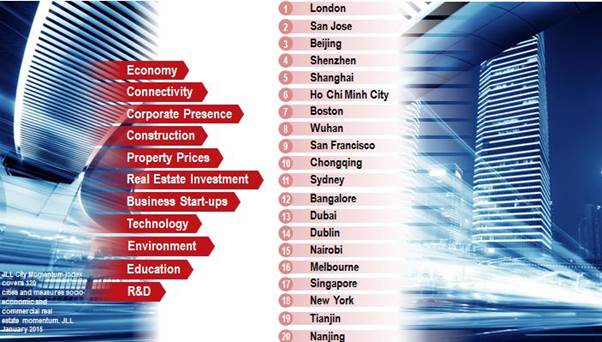 City Included In Top 20 Technology-Rich Cities in JLL’s global ‘City Momentum Index’
City Included In Top 20 Technology-Rich Cities in JLL’s global ‘City Momentum Index’
Anuj Puri, Chairman and Country Head at JLL India
Bangalore has helped India debut on the ‘City Momentum Index’ (CMI) Top 20 list – an annual survey carried out by Jones Lang LaSalle globally. Reinforcing the city’s status of being one of India’s premier technology centres, Bangalore figures at No. 12 in the Top 20 technology-rich cities globally. The economic as well as real estate momentum has gained pace as tech-industry majors line up to enter the market, or expand, here.
This year’s CMI includes new variables that reflect the importance of innovation to a city’s competitiveness and dynamism. Bangalore performs strongly on these measures, with its capacity for innovation leading to the largest number of international patent applications in India. An increase in the number of high-tech startups registered in the city over the past year has also helped boost Bangalore’s score, reflecting its strengths in innovation and depth of venture capital funding.
Infrastructure investments such as Bangalore metro and a bus rapid transport system on the outer ring road (ORR), together with a rise in foreign direct investment projects, are also contributing to strong economic growth, which is expected to reach 8% this year and make Bangalore among the fastest-growing major cities in the world.
Bangalore’s strong performance has also been boosted by some of world’s highest levels of prime office space construction, absorption and rental increases. Interestingly, Bangalore pipped other Asia Pacific cities in demand for office spaces. Robust demand for commercial space from the IT sector and associated IT-enabled services is helping boost absorption levels – highest in the Asia Pacific region.
Office rents are also growing strongly and Bangalore figures in the top 20 of JLL’s Q1 2015 ‘Global Office Index’. Construction is increasing to meet the demand generated by Bangalore’s rapidly expanding economy. An increase of around 5-10% in prime office rents will be seen in 2015.
Bangalore’s top scores in the CMI (rank out of 120 cities):
- GDP Growth 2014 (6)
- Population Growth (8)
- Real Estate Market Transparency Improvement (8)
- Office Net Absorption (as % stock) 2014 (11)
- Projected Office Rental Growth 2015 (14)
- FDI Count 2014 (14)
While outside the top 20, Delhi and Mumbai are beginning to see an increase in momentum as economic growth picks up and demand for prime office space strengthens.
Market Dynamics
Year after year, Bangalore has remained very close to the demand-supply equilibrium in commercial real estate. The net absorption between 1Q14 and 1Q15 was around 700,000 sq m. An equivalent of 8.4% of current office stock will be built over 2015 and 9.5% in 2016 – adding up to a cumulative total of about 18% over both years.
Considering a net leasable area of 65 million sq ft currently, this would translate into 5.5 million sq ft of office stock getting added this year and 6.2 million sq ft in 2016 – in an ideal scenario i.e. when delays do not occur in construction work. Though the office occupier profile is changing with more companies in the eCommerce and BFSI sectors leasing commercial spaces across the city, a majority of the leasing activity remains IT and ITeS-driven.
As far as popular office sub-markets are concerned, Whitefield is already saturated and Electronic City does not see much traction. The latter mostly has only back-end offices as the rents here are cheaper than most other sub-markets. Companies, especially in the BFSI and eCommerce sectors, prefer the eastern and northern stretches of ORR due to good connectivity and a lack of supply in other sub-markets.
In these two sub-markets alone, 5.8 million sq ft were absorbed in 2014 against a total absorption of 8.7 million sq ft in the entire city. Rents in these two sub-markets alone are expected to increase by 8-10% in the second-half of 2015 as against the average rent increase of 6% expected across the city in the corresponding period.

